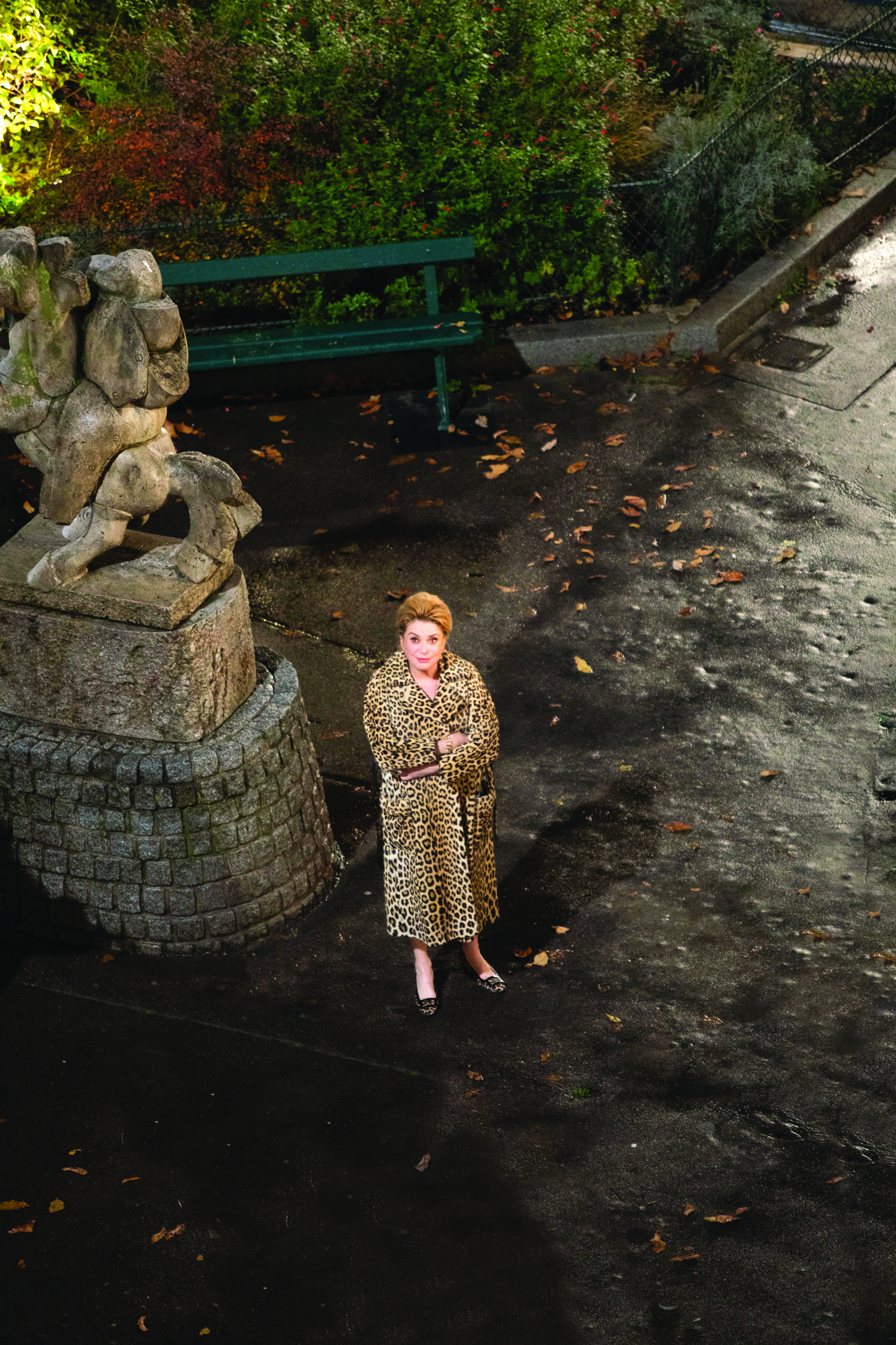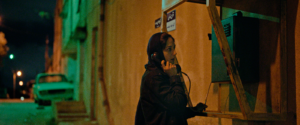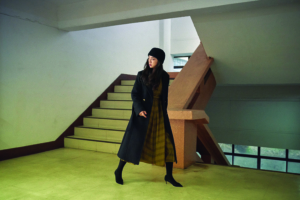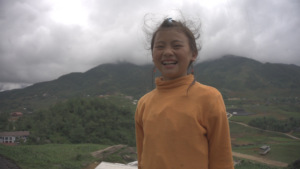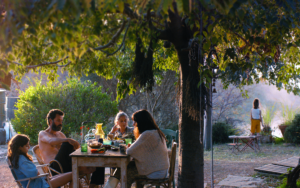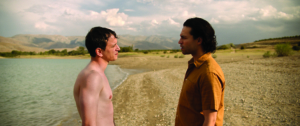Although there’s no shortage of films sharing the same name, something feels precarious about the title of Hirokazu Koreeda’s latest work – The Truth in English, Shinjitsu in Japanese, La vérité in its original French – and the way it confidently announces itself. To begin, the film marks the first time Koreeda has worked outside Japan and in a language he doesn’t speak, and the history of Japanese directors abroad is short and unimpressive. There also already exists a well-regarded French film of the same title (Henri-Georges Clouzot’s 1960 drama, starring Brigitte Bardot), not to mention that the word ‘truth’ (vérité) carries grand connotations in French cinema history. From Jean-Luc Godard’s dictum that ‘cinema is twenty-four frames of truth per second’[1]‘Le cinéma, c’est vingt-quatre fois la vérité par seconde.’ Spoken by Bruno (Michel Subor) in Godard’s The Little Soldier (1963). to the cinema vérité movement that proudly embedded the word in its own name, ‘truth’ is synonymous with the artform, striking at the heart of what cinema is, or is purportedly meant to be. And yet: The Truth!
But The Truth also refers to something more modest, something literal. It’s the title of a book within the film – a memoir soon to be published by Fabienne Dangeville, a legendary French actress in the twilight of her career (much like Catherine Deneuve, who plays her). Ostensibly to celebrate the book’s release, Fabienne’s semi-estranged daughter, Lumir (Juliette Binoche), returns to Paris from New York, where she works as a screenwriter; she brings along her American husband, Hank (Ethan Hawke) – a second-rate TV actor, both in his own words and in Fabienne’s eyes – and their young daughter, Charlotte (Clémentine Grenier). Upon arriving at the lavish home in which she grew up (located, suggestively, next to a prison), Lumir wastes no time in diving into the book, pen and post-it notes at the ready.
She quickly learns that her mother’s version of The Truth is far from truthful. It paints a picture of family life far rosier than the one Lumir knew from her childhood, and Fabienne’s many flaws have been swept aside in favour of an idealised legacy that the actress is trying to leave behind. Particularly contentious is the absence of a woman named Sarah Mondavan, Fabienne’s former friend and rival actress who died on the cusp of fame, and whom Fabienne had double-crossed for the role that propelled her to stardom many years ago; Sarah was also, it turns out, something of a mother-figure for Lumir in Fabienne’s absence. When Fabienne is confronted by her daughter, the imperious actress is unfazed. In fact, she readily admits that the book is untruthful (‘I’m an actress – I won’t tell the naked truth; it’s not interesting’), and even seems proud of having prioritised her career above all else (‘I’d prefer to be a bad mother, a bad friend, but a great actress’). Adding further layers to this troubled mother–daughter relationship is Fabienne’s current role in an indie sci-fi film – conveniently titled Memories of My Mother – as the elderly daughter of a young woman who doesn’t age. Fabienne feels threatened by her co-star, a rising talent by the name of Manon Lenoir (Manon Clavel); the young actress bears a close resemblance to Sarah, and their on-screen relationship begins to resonate in Fabienne’s real-life relationship with Lumir, and vice versa.
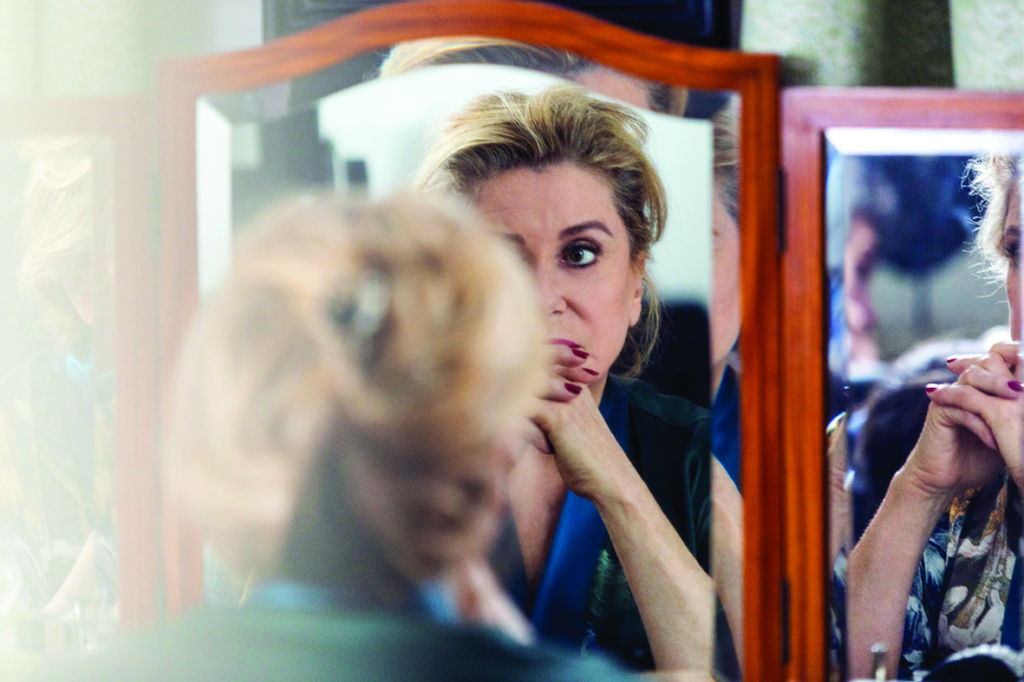
So The Truth does, after all, explore ‘truth’ as its subject – its slippery, illusive and elusive nature, and the way it is remembered, misremembered or wilfully forgotten, according to one’s needs and desires. In an unusually reflexive turn for Koreeda, the film also examines how truth is filtered and processed through cinema itself. For the first time since After Life (1998), but to a far greater extent than in that film, the act of filmmaking is explicitly foregrounded; a significant portion of the narrative unfolds around the film production (on sound stages, and in rehearsal spaces and dressing rooms), and almost every character is associated with the film industry in some way. The life–art duality between Deneuve and Fabienne is obvious enough – the role was written specifically for Deneuve, who clearly enjoys performing a variation of herself – but extends beyond perceived similarities in their careers and personalities. Deneuve’s middle name is Fabienne, and her sister, Françoise Dorléac, died as a promising actress on the brink of stardom. The film is peppered with cinematic references: Deneuve’s previous roles are glimpsed on posters and alluded to in the dialogue, French actors are regularly namechecked, and even Clouzot’s eponymous film receives a passing nod when Fabienne casually dismisses Bardot as a ‘so-so’ actress.
Despite these new elements – to say nothing of the new language, faces and setting – the basic core of The Truth is familiar territory for Koreeda. It’s a domestic, multigenerational family drama in which a character’s homecoming brings unresolved tensions to the fore – a premise comparable to those in recent films by the director such as Still Walking (2008) and After the Storm (2016). It’s also the latest in a string of films by Koreeda to feature a charismatic, and sometimes overbearing, matriarch (played in recent years by the peerless Kirin Kiki, who died a month before Koreeda begin filming The Truth). Through the spectral figure of Sarah, a past death also inflects the narrative as it does in most of his earlier work. Other familiar markers of Koreeda’s signature can be seen and felt: a passing train in the background of a shot, an emphasis on the season (autumn), a cooking scene, a strong performance by a child actor. On the surface, everything is new, but the hallmarks of Koreeda’s cinema remain very much intact in translation.
On this matter of translation, The Truth provides a particularly interesting case study. Films and filmmakers have been crossing national borders since the earliest days of cinema, but, historically, there has been little incentive for Japanese directors to work abroad. Long blessed with a robust domestic market and a national cinema with a reliable international following, most filmmakers have simply felt no need to try their luck outside their homeland.[2]This is the opposite case in Australia, where domestic films have long struggled to find an audience, prompting many filmmakers to head to Hollywood. More significant, however, is the fact that few Japanese directors are versed in a language other than their own. An international co-production can be an unwieldy process as it stands, posing an array of logistical and communicative challenges as well as demanding additional time and resources from all parties.[3]For a detailed discussion of the logistical and translational issues that hampered the production of Tora! Tora! Tora! (Richard Fleischer, Kinji Fukasaku & Toshio Masuda, 1970), a Japanese–US co-production that dramatised the Japanese attack on Pearl Harbor, see Abé Mark Nornes, Cinema Babel: Translating Global Cinema, University of Minnesota Press, Minneapolis & London, 2007, pp. 37–52. These pressures, combined with a director’s lack of familiarity with the host nation’s culture and language, can often result in lacklustre – or worse yet, offensive – films. ‘Japanese directors who film in foreign locations often find themselves out of their cultural and linguistic depth,’ suggests The Japan Times critic Mark Schilling. ‘The non-Japanese characters are stereotypes and the foreign-language dialogue is hokey. Meanwhile, the exotic setting serves only as a cliched backdrop for the Japanese protagonists, the true focus of the exercise.’[4]Mark Schilling, ‘The Truth: Kore-eda Effortlessly Crosses Borders’, The Japan Times, 9 October 2019, <https://www.japantimes.co.jp/culture/2019/10/09/films/film-reviews/truth-kore-eda-effortlessly-crosses-borders/>, accessed 28 April 2020.
Films and filmmakers have been crossing national borders since the earliest days of cinema, but, historically, there has been little incentive for Japanese directors to work abroad.
Even the finest Japanese directors have fallen prey to what Schilling describes,[5]Take, for example, Takeshi Kitano’s Brother (2000), in which a yakuza underboss establishes himself as the leader of a multiethnic gang in Los Angeles. The Japanese dialogue in the film is, as one might expect, consistently strong, but the English dialogue is frequently awkward. Likewise, the interactions between the Japanese and non-Japanese characters are rarely convincing, and the latter are only ever meaningful in relation to the former. Brother is Kitano’s only foray overseas, and his weakest film by some margin – and the source of the problem is apparent on its surface. but his observation applies equally to a vast number of films set in foreign locations, irrespective of their national origin. To turn the tables for a moment, Japan itself has long been a popular destination for filmmakers – and it’s hardly uncommon for the country to be used as little more than oriental decor, a series of exotic sights and sounds against which the narrative plays out. Hollywood films, in particular, often deal with linguistic and cultural challenges by simply removing them. At the cost of a diminished realism but with the benefit of a reduced need for subtitles, Japanese characters are permitted to speak perfect English, with the native tongue heard only occasionally if credulity is overstretched, or just for effect.[6]See, for example, The Yakuza (Sydney Pollack, 1974), Memoirs of a Geisha (Rob Marshall, 2005) and The Fast and the Furious: Tokyo Drift (Justin Lin, 2006); the latter two films also cast non-Japanese Asian actors as Japanese characters. Some films bypass the language barrier by conceiving narrative bubbles in which Japanese is barely required to be spoken in the first place, while others minimise it by installing a bilingual character who functions as a translator-guide, freeing up the visiting protagonist to pursue their goals unencumbered by the foreignness of the setting.[7]Examples of the former include Map of the Sounds of Tokyo (Isabel Coixet, 2009) and Enter the Void (Gaspar Noé, 2009); the latter include Black Rain (Ridley Scott, 1989) and Wasabi (Gérard Krawczyk, 2001). And in the many ‘culture clash’ comedies set in Japan, which generally rely on exaggerating cultural differences rather than downplaying them, Japanese customs and mannerisms are regularly distilled into quirky stereotypes that reinforce the cultural normalcy of the protagonist.[8]See, for example, Mr. Baseball (Fred Schepisi, 1992), Fear and Trembling (Alain Corneau, 2003) and Lost in Translation (Sofia Coppola, 2003).
Schilling’s observation is thus hardly unique to Japanese films, but it nevertheless highlights a crucial fact. Narrative films set in foreign countries typically feature characters who, much like the filmmakers themselves, are only visiting that country. They tend to be foreign in setting only, because the main characters and actors, as well as the narrative itself, have been imported; behind the camera, a homegrown film crew is also often brought in to fill key creative roles. To cite some recent examples by globetrotting auteurs: an Iranian man returns to Paris to settle a divorce in Asghar Farhadi’s The Past (2013), and a Taiwanese woman visits the same city as a tourist in Tsai Ming-liang’s What Time Is It There? (2001); a Japanese TV crew in Uzbekistan is the focus of Kiyoshi Kurosawa’s To the Ends of the Earth (2019), while Italy serves as the backdrop for a drama about upper-middle-class British holiday-goers in Joanna Hogg’s Unrelated (2007); and Wes Anderson, who has made a habit of setting his English-language comedies abroad, took his cast and crew to India for The Darjeeling Limited (2007), and created a fictitious Japan with the aid of stop-motion animation in Isle of Dogs (2018). Visiting filmmakers immerse themselves in the host nation’s culture to varying degrees (and to varying degrees of success), but they rarely dispense altogether with comforts from home – indeed, their films are usually built around these comforts.
In this regard, The Truth stands apart from most other ‘crossover’ films. As far as what is on the screen is concerned, the film represents a clean break between the director and his country: less a Japanese director making a film in France than it is a bona fide French film by a Japanese director. There is barely a hint of Japan in the film: no actors, no allusions to it in the narrative, not a mention of anything remotely Japanese.[9]The closest the film gets is a minor in-joke. When Fabienne burns her tongue from drinking hot tea, she makes a remark whose meaning may not click for many viewers: ‘I’m like a cat’ – a reference to the Japanese phrase nekojita (literally, ‘cat tongue’), used to describe those who have difficulty consuming hot drinks and food. Koreeda also made the bold choice to work with an entirely French crew (‘If I’m going to make a movie in France, I might as well go all in,’ he explains[10]Hirokazu Koreeda, quoted in Matt Schley, ‘Hirokazu Kore-eda on The Truth, Working in France and Filmmaker Fatigue’, Screen Daily, 6 October 2019, <https://www.screendaily.com/features/hirokazu-kore-eda-on-the-truth-working-in-france-and-filmmaker-fatigue/5143517.article>, accessed 28 April 2020.), and his assistant and interpreter were the only Japanese speakers present during the shoot.[11]This interpreter, Léa Le Dimna, may be the film’s unsung hero. She was deeply involved in every step of the process, working with Koreeda to adapt his Japanese screenplay into French, providing him with feedback about the actors’ performances between takes and translating footage as he edited the film – in addition to facilitating all communication between the director and his French collaborators. See ‘Interview de Léa Le Dimna’, Association des Traducteurs/Adaptateurs de l’Audiovisuel website, 22 May 2019, <https://beta.ataa.fr/blog/article/interview-de-lea-le-dimna>, accessed 18 May 2020. Casting two of France’s greatest living actors is a kind of luxury afforded to very few visiting filmmakers, and one that can’t be understated. Their involvement alone offered a kickstart to the film’s commercial prospects in France and abroad, and reduced the financial risk of handing a non-French speaker the reins. More importantly, it ensured a standard of performance easily capable of absorbing the many issues that inevitably arise when collaborators don’t share the same language.
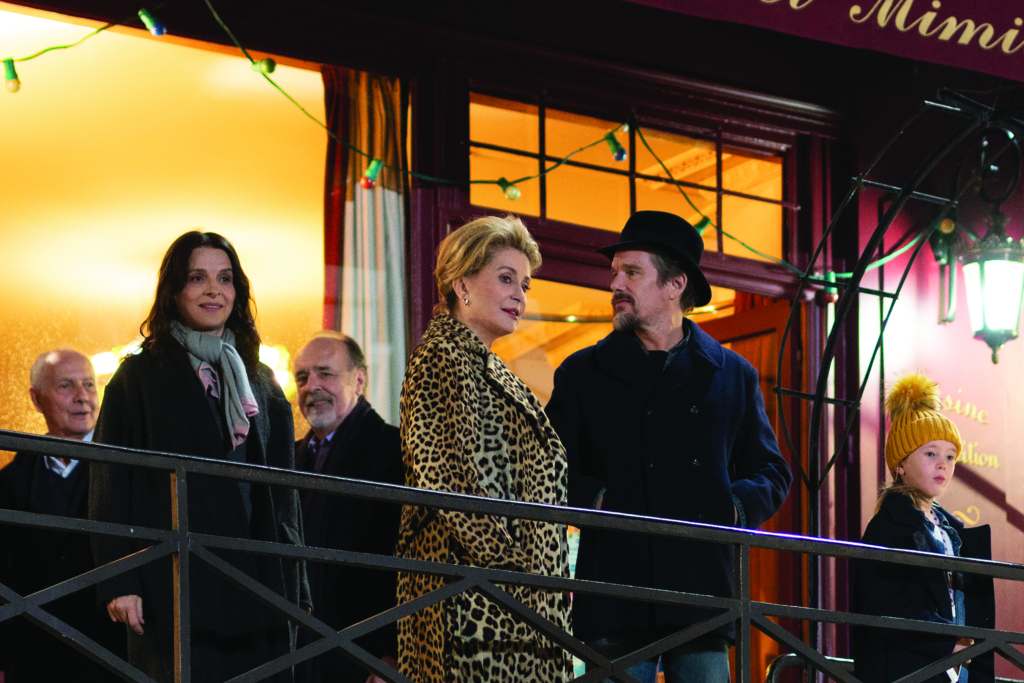
Insofar as the film’s tone, settings, dialogue and characters feel wholly authentic, The Truth is a resounding success of boundary-crossing cinema. Many critics have been quick to remark on the fluidity with which Koreeda has handled the intrinsically French setting, noting the film’s ‘palpable sense of Frenchness uncommon for a visiting filmmaker’,[12]Charles Bramesco, ‘The Truth – First Look Review’, Little White Lies, 7 September 2019, <https://lwlies.com/festivals/the-truth-first-look-review-hirokazu-koreeda-juliette-binoche-ethan-hawke/>, accessed 28 April 2020. its ‘comic lightness that feels authentically French’[13]Schilling, ‘Kore-eda Effortlessly Crosses Borders’, op cit. and that it feels ‘so spryly at home in the cosmopolitan air of its French movie-world setting’.[14]Owen Gleiberman, ‘Film Review: The Truth’, Variety, 28 August 2019, <https://variety.com/2019/film/reviews/the-truth-review-catherine-deneuve-hirokazu-kore-eda-1203316581/>, accessed 28 April 2020. The Truth is a rare example wherein a filmmaker has reached a point in their career at which they possess the required confidence and skills – and can surround themselves with the necessary resources and talent – to be able to work in a genuinely foreign environment, while practically eliminating the language barrier as a factor.
For all these virtues, however, The Truth is ultimately an underwhelming work, a film that showcases the brilliance of its filmmaker while never coming close to brilliance itself. Its weaknesses aren’t due to any cultural oversights, or related to matters of mistranslation. Paradoxically, it’s through the film’s own rigour and attention to detail in its foreign setting that it falters. In interviews, Koreeda has stated his desire to avoid a tourist’s view of Paris and to shoot the city ‘from the perspective of ordinary people’,[15]Hirokazu Koreeda, quoted in Chris Gallagher & Mike Davidson, ‘Japan’s Kore-eda Says The Truth Could Only Have Been Made with Deneuve’, Reuters, 2 October 2019, <https://www.reuters.com/article/us-film-the-truth/japans-kore-eda-says-the-truth-could-only-have-been-made-with-deneuve-idUSKBN1WH0RI>, accessed 28 April 2020. with his main solution being to limit the number of locations and confine most of the narrative within Fabienne’s beautiful Parisian home[16]See Mark Schilling, ‘Hirokazu Kore-eda Steps Out of His Comfort Zone’, The Japan Times, 6 October 2019, <https://features.japantimes.co.jp/kore-eda/>, accessed 14 May 2020. (‘Paris in the film is pretty much left as an idea, an anecdote in the background,’ writes Elisabet Cabeza in her Sight & Sound review[17]Elisabet Cabeza, ‘The Truth First Look: Koreeda’s French Family Blowout Pits Catherine Deneuve Against Juliette Binoche’, Sight & Sound, 19 March 2020, <https://www.bfi.org.uk/news-opinion/sight-sound-magazine/reviews-recommendations/truth-verite-koreeda-catherine-deneuve-juliette-binoche-french-family-blowout>, accessed 14 May 2020.). This may have been a sensible decision in terms of both authenticity and practicality, but a consequence is that The Truth ends up fitting too easily, and sitting too comfortably, within a pre-existing template of French cinema – that of a star-studded ensemble drama, set in an elegant upper-class milieu that is the domain of countless other films – that strips the film of urgency and distinctiveness. In Koreeda’s earlier films, however modest and domestic their focus might be, external societal pressures always play a crucial role in shaping the dynamic between characters, and particularly between family members. No such pressures can be felt in The Truth because the protagonists, whose lives and circumstances are anything but ‘ordinary’, seem immune to any influence outside their immediate personal relationships.
Some of Koreeda’s films – including his previous one, the Palme d’Or–winning Shoplifters (2018) – are also about downtrodden people for whom destitution and incarceration are real prospects; but here, the prison that is adjacent to Fabienne’s home is flagged only as a metaphor that functions in relation to its affluent characters. In choosing this world as the setting of his first foreign film, Koreeda has unwittingly created his own bubble, safely shielded from society and its problems – and the prison becomes a reminder of where the film never goes, or is never even given the opportunity to go. Much of the film’s apparent thematic complexity also becomes camouflaged by its lightness, in some cases proving to be wholly illusory. For example, expectations that there might be reflexive parallels between Koreeda and the young director of the film-within-the-film, who initially appears out of his depth working with an actor of Fabienne’s stature, or Hank, a foreign outsider who is the only character not to speak French, quickly turn out to be unfounded. With the exception of the metatextual links between Fabienne and Deneuve, there is far less interplay between truth and fiction, life and art, reality and performance than is suggested by the film’s title or its cinema-centric narrative.
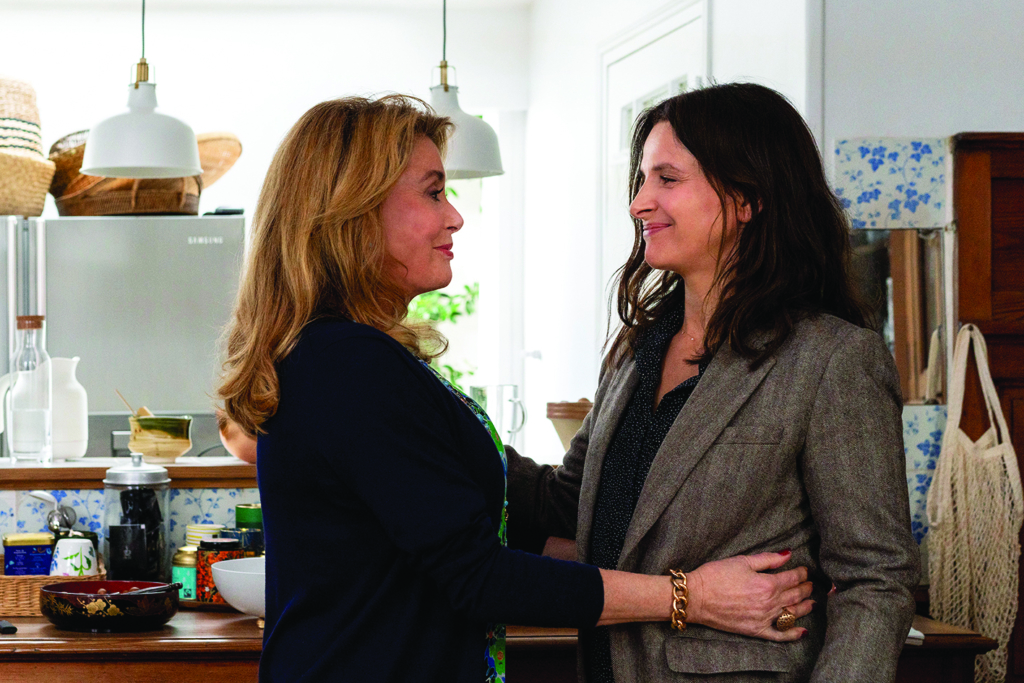
By the end of the film, Fabienne reveals herself to be not quite the unflinching grande dame or unloving mother that she’s made out to be. As her film shoot progresses, her fears and insecurities bubble to the surface; she forgets her lines and panics on set, and her anxiety spills out at home, where she’s eventually drawn to her daughter for reassurance. Lumir comes to oscillate between two overlapping roles: the first as her mother’s critic, being one of the few able and willing to stand up to her; and the second as her daughter, who is compelled to try and love and be loved, despite everything. The one truth that the film is able to settle on is thus a simple one, reiterated many times over in Koreeda’s vast and varied filmography: family is family, like it or not. That this particular truth remains intact, and so affecting, is a testament to both the simplicity and flexibility of Koreeda’s cinema.
Exhausted after a five-year patch in which he made five films, Koreeda is now going to take a well-earned break; he hasn’t yet indicated whether he’ll be returning home to Japan for his next film, or going somewhere new.[18]See Schilling, ‘Kore-eda Steps Out’, op. cit.; and Schley, op. cit. The Truth may be one of his lesser films, but with it, we can rest assured in the knowledge that his cinema can speak many tongues – and can likely come and go as it pleases.
Endnotes
| 1 | ‘Le cinéma, c’est vingt-quatre fois la vérité par seconde.’ Spoken by Bruno (Michel Subor) in Godard’s The Little Soldier (1963). |
|---|---|
| 2 | This is the opposite case in Australia, where domestic films have long struggled to find an audience, prompting many filmmakers to head to Hollywood. |
| 3 | For a detailed discussion of the logistical and translational issues that hampered the production of Tora! Tora! Tora! (Richard Fleischer, Kinji Fukasaku & Toshio Masuda, 1970), a Japanese–US co-production that dramatised the Japanese attack on Pearl Harbor, see Abé Mark Nornes, Cinema Babel: Translating Global Cinema, University of Minnesota Press, Minneapolis & London, 2007, pp. 37–52. |
| 4 | Mark Schilling, ‘The Truth: Kore-eda Effortlessly Crosses Borders’, The Japan Times, 9 October 2019, <https://www.japantimes.co.jp/culture/2019/10/09/films/film-reviews/truth-kore-eda-effortlessly-crosses-borders/>, accessed 28 April 2020. |
| 5 | Take, for example, Takeshi Kitano’s Brother (2000), in which a yakuza underboss establishes himself as the leader of a multiethnic gang in Los Angeles. The Japanese dialogue in the film is, as one might expect, consistently strong, but the English dialogue is frequently awkward. Likewise, the interactions between the Japanese and non-Japanese characters are rarely convincing, and the latter are only ever meaningful in relation to the former. Brother is Kitano’s only foray overseas, and his weakest film by some margin – and the source of the problem is apparent on its surface. |
| 6 | See, for example, The Yakuza (Sydney Pollack, 1974), Memoirs of a Geisha (Rob Marshall, 2005) and The Fast and the Furious: Tokyo Drift (Justin Lin, 2006); the latter two films also cast non-Japanese Asian actors as Japanese characters. |
| 7 | Examples of the former include Map of the Sounds of Tokyo (Isabel Coixet, 2009) and Enter the Void (Gaspar Noé, 2009); the latter include Black Rain (Ridley Scott, 1989) and Wasabi (Gérard Krawczyk, 2001). |
| 8 | See, for example, Mr. Baseball (Fred Schepisi, 1992), Fear and Trembling (Alain Corneau, 2003) and Lost in Translation (Sofia Coppola, 2003). |
| 9 | The closest the film gets is a minor in-joke. When Fabienne burns her tongue from drinking hot tea, she makes a remark whose meaning may not click for many viewers: ‘I’m like a cat’ – a reference to the Japanese phrase nekojita (literally, ‘cat tongue’), used to describe those who have difficulty consuming hot drinks and food. |
| 10 | Hirokazu Koreeda, quoted in Matt Schley, ‘Hirokazu Kore-eda on The Truth, Working in France and Filmmaker Fatigue’, Screen Daily, 6 October 2019, <https://www.screendaily.com/features/hirokazu-kore-eda-on-the-truth-working-in-france-and-filmmaker-fatigue/5143517.article>, accessed 28 April 2020. |
| 11 | This interpreter, Léa Le Dimna, may be the film’s unsung hero. She was deeply involved in every step of the process, working with Koreeda to adapt his Japanese screenplay into French, providing him with feedback about the actors’ performances between takes and translating footage as he edited the film – in addition to facilitating all communication between the director and his French collaborators. See ‘Interview de Léa Le Dimna’, Association des Traducteurs/Adaptateurs de l’Audiovisuel website, 22 May 2019, <https://beta.ataa.fr/blog/article/interview-de-lea-le-dimna>, accessed 18 May 2020. |
| 12 | Charles Bramesco, ‘The Truth – First Look Review’, Little White Lies, 7 September 2019, <https://lwlies.com/festivals/the-truth-first-look-review-hirokazu-koreeda-juliette-binoche-ethan-hawke/>, accessed 28 April 2020. |
| 13 | Schilling, ‘Kore-eda Effortlessly Crosses Borders’, op cit. |
| 14 | Owen Gleiberman, ‘Film Review: The Truth’, Variety, 28 August 2019, <https://variety.com/2019/film/reviews/the-truth-review-catherine-deneuve-hirokazu-kore-eda-1203316581/>, accessed 28 April 2020. |
| 15 | Hirokazu Koreeda, quoted in Chris Gallagher & Mike Davidson, ‘Japan’s Kore-eda Says The Truth Could Only Have Been Made with Deneuve’, Reuters, 2 October 2019, <https://www.reuters.com/article/us-film-the-truth/japans-kore-eda-says-the-truth-could-only-have-been-made-with-deneuve-idUSKBN1WH0RI>, accessed 28 April 2020. |
| 16 | See Mark Schilling, ‘Hirokazu Kore-eda Steps Out of His Comfort Zone’, The Japan Times, 6 October 2019, <https://features.japantimes.co.jp/kore-eda/>, accessed 14 May 2020. |
| 17 | Elisabet Cabeza, ‘The Truth First Look: Koreeda’s French Family Blowout Pits Catherine Deneuve Against Juliette Binoche’, Sight & Sound, 19 March 2020, <https://www.bfi.org.uk/news-opinion/sight-sound-magazine/reviews-recommendations/truth-verite-koreeda-catherine-deneuve-juliette-binoche-french-family-blowout>, accessed 14 May 2020. |
| 18 | See Schilling, ‘Kore-eda Steps Out’, op. cit.; and Schley, op. cit. |
